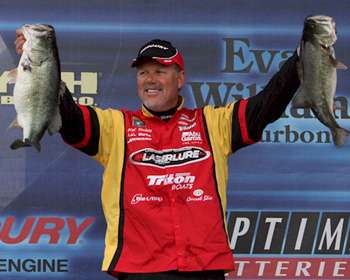
When it comes to selecting a color for a topwater bait, Elite Series angler Boyd Duckett says that variation and experimentation are crucial to taking full advantage of bass on top.
The Alabama pro's first Bassmaster win came on a topwater lure, and he has amassed an impressive resume with the technique on waters in his home state. "Topwater fishing is a style I like to capitalize on when I have the opportunity," he says.
While the former Classic Champion has some general guidelines for selecting a color for his topwater, he isn't restricted by norms, notions or rules. Rather than discuss when a chartreuse stripe, red patch on the throat of the bait, or slightly different shad pattern works best, Duckett is quick to bring up the importance of experimentation when it comes to selecting the perfect color.
"If I think topwater will be my predominant pattern, you'll probably see five colors of the same bait in the bait tray in my boat," he claims. "As soon as I get a short strike, a swirl or a bass that isn't hooked very well, I'm going to change colors because I believe bass are very color sensitive. Instead of trying to explain why, the most important thing is to take the time to change and not worry why."
Duckett says that when it comes to changing the color of a topwater bait, many anglers are resistant to do so. He stresses that this practice is no different than changing the color of your plastic worm. "If you're not willing to change worm colors, you're probably not going to be a very successful worm fisherman. Color matters, and it's no different with topwater. You have to be willing to change," he explains.
That being said, there has to be a starting point and Duckett's starting point is usually a topwater featuring a white or off-white belly. When throwing a Lucky Craft Sammy or Laser Lure Laser Walker, colors like "Ghost Minnow" and "Yellow Ghost" are his initial choices. "I like that color because it gives the bait a natural look and has a baitfish colored bottom," explains Duckett. "The top of the bait is not nearly as significant as the color on the bottom."
When fishing highly pressured lakes or facing a spooky bite, Duckett reaches for a clear topwater plug. "In tough conditions, the advantage of a clear topwater is that the bass can't see the bait well, especially one that's constantly on the move, like a walking bait. They'll strike it because they really can't decide what it is," he explains. Under sunny skies, a chrome finish often gets the nod and in cloudy conditions, Duckett says black can be an extremely effective topwater color.
"The key is to be willing to change colors until you find one the bass are willing to eat. While there are some basic guidelines for a starting point, you must be willing to experiment," Duckett reiterates.




